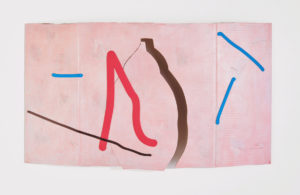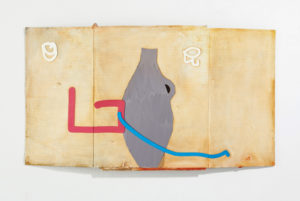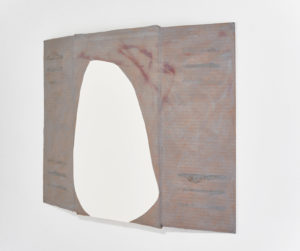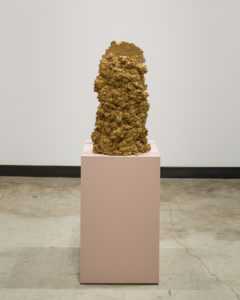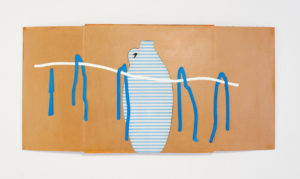September 3, 2015—October 10, 2015 | Opening Reception: Thursday, September 3rd, 6-8PM
James Harris gallery is pleased to present our second exhibition by Jenny Heishman entitled, Dressing Room. For this show, Heishman has created a series of new works to reexamine the vessel, a familiar form from her early artistic pursuits in ceramics. In the early 1990s, Heishman spent many years developing the craft of a functional potter. Since then, her sculptural practice has expanded with her playful yet austere approach to materials, all the while maintaining the sensibility informed by her history with the ceramic process. The title Dressing Room refers to Heishman’s desire to unpack the elemental meaning of common objects and familiar forms by interrupting the ways we typically encounter them. Heishman’s practice has a Nouveau Realist sensibility, placing focus on gestures, recognizable forms, and simple contingencies.
Heishman is especially interested in the tension of contained space suggested by the vessel, that is at once considered utilitarian and symbolic. She explores this tension in her wall-mounted works of simple vessel form cut-outs and silhouettes through the parsing of another common container, the cardboard box. The box sides and their flaps are mounted to the wall to create a pocket of real space. While the representation is two dimensional, it becomes its own physical object, highlighting its corporeal attributes of weight and profile. Digitally inspired lines glide across the surface, further disrupting the reality and depth perception through an allusion to a flat screen experience of virtual space. In this sense, her pieces are placeless, resisting their own permanence. Both the fragility of the materials and a purposefully compromised structure present an identity of the vessel as a sum of its elemental parts (the profile, the decoration, the shadow on the table, and the space it holds) rather than as a unified whole.
Accompanying the wall pieces are a pair of raw cardboard pulp vertical wedges that have been similarly dislodged from a structural support. These organic forms exist in pure materiality, barely composed with ever-so-slightly concave sides facing one another to hold space. The relationship between the two creates a visceral experience of containment that reverberates out to the architectural space of the viewer.
The works in this show offer new assimilation through a deconstruction of form, distilling the elements from the whole, and making them strange and then familiar again. Through this disruptive interaction, we become reacquainted with the vessel. Heishman’s practice unfolds through a series of experimental processes to “explore what it feels like when something we know looks back at us in a new way.”
Cardboard, mat board, paint, sharpie, varnish
19" x 33" x 3"
Inquire about this work
Cardboard pulp, tinted gesso, PVA size, laminate, and MDF shelf
14 1/2" x 25 1/2" x 8 1/8"
Inquire about this work
Cardboard, mat board, paint
15 1/2" x 28 1/2" x 2"
Inquire about this work
Cardboard pulp, PVA size, laminate, MDF pedestal
50" x 16" x 16"
Inquire about this work
Cardboard, mat board, paint, varnish
15 1/2" x 32" x 2"
Inquire about this work

